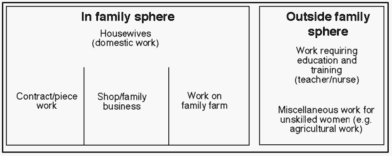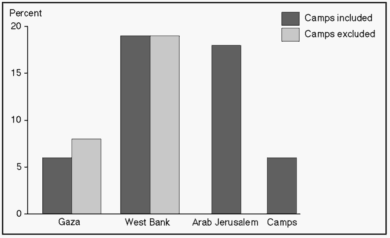
|
Female Labour Activity59What is the essence of women's work compared to that of men? Any attempt to give a satisfactory answer to this question requires a discussion of the meaning of "work". Simon Levenhardt suggests the following definition60:
Activities classified under (a) are clearly in accordance with the ILO definitions for work used in this survey. In most Palestinian households these activities are, however, usually considered men's responsibility. Women, on the contrary, are expected primarily to engage in activities classified under (b) and (c) above. While many non-market activities classified under (b) are included in ILO definitions for work, most activities mentioned under (c) are not. The issue of how to view reproduction in an economic context has long been controversial. Even if reproduction of life is the material basis for the labour force, and thus constitutes the very foundation of the economy, it is usually not considered as "production". The unpaid nature of female domestic "duties" does not imply that these are of no economic interest or have no productive value. Investment in domestic labour saving devices like washing machines and modern kitchen equipment, give indications of the economic importance of house work. House work does not, however, generate direct income which can be used for acquisition of consumer goods in the market. For many women, lack of income generating employment also implies limited control of liquid economic resources. In a living conditions perspective, women may perceive this as a constraint on their ability to pursue their interests61. Figure 7.29 presents an overview of female labour activities. Work conducted inside the house as part of the housewife's tasks is, as could be expected, most important in terms of time62. Other work done in a domestic setting may be contract or piece work, particularly sewing clothes, work in a family shop or business, garden plot or farm, or food-processing. Out-of-house employment can be found mainly among five groups of women: The highly educated, young unmarried women, widows, divorcees and women without children.
Figure 7.29 Graphical presentation of female employment: In spite of numerous efforts undertaken when designing the FAFO survey, it proved difficult to capture women's work. A female labour force participation ratio of a mere 14% shows that most women have understood "work" as paid work, primarily conducted outside the home. Figure 7.30 illustrates the perception of "work" among women presenting labour force status of women performing various economic activities63.
Figure 7.30 Labour force participation ratios for working women by location of work
Female Labour Force Participation64 The variations in female labour activity which emerge when linked to "objective" socio-economic background variables, are very similar to those for men. As figure 7.31 illustrates, female labour force participation is particularly low in Gaza, and in refugee camps. These habitats thus seem to offer very weak employment possibilities for both sexes. With respect to individually related "objective" background variables, the highest female participation ratios can be found among educated women and among women from wealthy households.
Figure 7.31 Female labour force participation rates by region Women's attitudes towards work outside the home are rather mixed. There seems to be a widespread perception among women that work outside the house is associated with low status. The very high labour force participation ratio among divorced and separated women, who are usually accorded low social status, and the relatively high rate of work among female Heads of Household, illustrate this point. Professional work, on the other hand, seems to be regarded as acceptable. The relatively high number of wealthy, educated working women we have observed are probably motivated for work for such reasons as desiring to make proper use of their education and to achieve "self-realization", rather than economic necessity. It is difficult to disentangle the impact of the culturally motivated norms governing female labour activity outside the home. There is a complex interplay between the attitudes of family members, in particular Heads of Household, and the attitudes in the local community. Many employers may also harbour prejudices as to the ability of women to take part in working life. Women themselves tend to internalize scepticism to female labour activity. Most women thus avoid "non-respectable" labour activities, e.g. work which involves public contact with men65. The Israeli labour market is avoided in particular, irrespective of the relatively high wage levels potentially available66. Different labour force participation ratios for Moslem and Christian women in the West Bank and Arab Jerusalem could indicate the existence of cultural inhibitions towards women's work. The observed difference is, however, also partially caused by the Christians' higher average education and higher score on the wealth index67. With regard to women's freedom of movement, those "free to move at will" have a higher labour force participation than other women do68. The increase in labour force participation for Gaza women reaching their menopause may be an indication of cultural inhibitions towards women's work, but may also reflect the fact that less time is required for child care. The very low participation among the youngest Gaza women compared to West Bank women in the same age group, is most likely caused by the lack of employment opportunities in Gaza, although it may also comprise an element of stronger scepticism towards female employment in that region.
Female (Income Generating) Employment69 Figure 7.32 illustrates how women's use of time varies with labour force participation. Labour force members do less housework than non-members, but still have "full-time" jobs discharging household obligations. Working women thus seem to have a double set of jobs, a phenomenon also observed in Western countries70.
Figure 7.32 Weekly time use for women by labour force status In conclusion, when engaging in income generating employment, women often seek job types, locations and work hours that allow a combination of home, child care and work. Ability to ensure that work does not get in the way of family obligations is an absolute requirement for women accepting conventional employment.
|
 al@mashriq 960715 |



